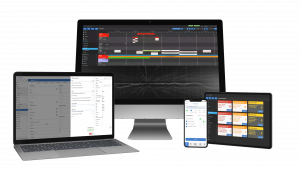How tech is making aviation more efficient
Could you introduce yourself and explain your background and involvement with myairops?
I joined myairops a little over 4 and a half years ago at a point that our parent organization wanted to execute a major strategic re-plan. I have held senior positions in technology and aviation businesses working for some of the largest global organizations as well as start-up positions. I started my career as a software engineer writing engine control and simulations in the aviation space before moving in to search technologies, linguistic analysis, machine learning and cyber security. I have always had a passion for aviation and have worked in and around the aviation industry for the last 25 years in both military and business aviation. Since joining myairops I have established a phenomenal team of people who together have built some of the most modern cloud capabilities that exist within the aviation market today. We are 3 years in to our initial 5-year plan which due to the pandemic has seen some significant re-planning along the way. Together we have established a close working relationship with a global customer base across a wide portfolio of products and services.
Can you explain what myairops is and why it exists?
The company exists to perform one simple mission and that is to provide a set of advanced technologies to the aviation market which can be used by any organization, no matter the size. We believe that our strength is in our team, the ideas generated by our customers and our expertise in the aviation sector. We set out with a clear vision to put automation and data at the heart of everything we do. You cannot automate if you do not have the correct data and to get the data in to the system you need to have an open and scalable architecture which offers data interoperability through modern APIs and cloud-based technologies. We partnered early on with the Microsoft Cloud to enable us access capabilities like cognitive services, scalable applications, and infrastructure but also to ensure we could deploy our services around the globe to enable our customers to meet their data sovereignty requirements. When we set out on our mission, we knew automation was key. There are still too many tasks within operational workflows that rely heavily on people and their expertise. Frequently working across many systems that are not interconnected, the scale of complexity grows and the workload increases. This has now been compounded by the global shortage of skilled workers within the aviation industry so there is an even greater importance to ensure the workforce is supported by systems that can make decisions on behalf of the users, whilst getting experts involved at the necessary point. This means organizations can achieve more than they have done in the past. Through the use of technology like ours, companies can grow with their demand and scale teams in more manageable ways than in the past.

Can you explain what problem you are solving in the aviation industry and why?
myairops exists to solve the efficiency problem that all organizations face. What we have recognized is that different organizations have differing problems and there is no ‘one size fits all’ solution. This has meant we have focused on ensuring our products are the most interoperable in the market. To put it simply, data integration is paramount but looking at how this data is integrated is important. The first approach is to move data between systems. This removes the initial challenge of having to enter the data more than once. However, myairops goes further, we look at the end-to-end business process, analyze where inefficiency and waste is present and optimize it. This means organizations can achieve ‘more for less’. This is a highly configurable process, and we worry about every button press, every click as repetitive tasks that have waste in them can mount up. The next part of what we do is automate. Automation takes the form of processing everything that does not need a human to become involved. Imagine a situation where today you are continually checking everything with respect to a flight, changes in the trip details, passenger manifest changes, crew fatigue and duty constraints, weather, and the maintenance considerations around the aircraft. This can become overwhelming especially with smaller teams or large fleets or complex high-volume operations. Our solution digitizes and automates the decision-making process, in this scenario alerting the human operator to evaluate only the items that are now nearing or outside of operational parameters and need human intervention. This significantly cuts down on the overall workload on a busy team. Through our products we have allowed our customers to be able to place their aviation software inside their technical and IT strategy. For many years the aviation software sat disconnected from other business software and solutions. We have ensured that our solutions slot in directly and allow information and business intelligence to flow freely around the organization. The breadth of our capability also means we can control and adapt the end-to-end business process. Take for example our myairops flight and myairops fbo products. The first is designed for aviation operations such as staff rostering, scheduling of flights and maintenance (to name a small sub-section of its capabilities) and the second product is for organizing FBO facilities such as ramp handling, parking, and service delivery. We are already combining these products to solve challenges in new and emerging sectors of our industry. eVTOLs and the vertiports that they will operate from are going to be high turnaround environments needing to make critical decisions around when to take offline and charge, when to swap crew and other decisions such as this. To make those decisions efficient, its necessary to combine all the intelligence and operational information to a single operational picture. Now weave in to this our myairops cam maintenance tracking software and our stores and inventory capabilities and you can see how we can help companies either by taking a single product or a connected suite of products. We of course cannot achieve everything on our own and we have built close working relationships with others in our industry. Always putting operational data and business process workflow automation at the forefront of everything we do.
What changes have you observed in the industry over the last 5 years and how have you adapted?
Clearly, it’s impossible to answer a question like that without mentioning the COVID pandemic. This has placed a huge strain on the aviation industry. Closing borders and restricting the flow of movement meant that companies that were already existing on slim margins had their revenue streams cut instantly with little or no warning. Even with support from global governments we saw an unprecedent level of people decide to leave the aviation sector in its entirety and we are not yet seeing a recovery of that workforce. Even where people are returning, there is clearly a lead time to be able to deliver the necessary training to enable those people to fulfil the demands our industry has from the labor market. Another major trend is consolidation, and coupled with the impacts I have already mentioned, this has accelerated the consolidation we are seeing in business aviation market. That consolidation is not only taking the form of M&A but also through the growth of partnerships. There are amazing companies in the market that within their specific niche, or area of expertise, we have seen some innovative approaches to certain problems. Organizations need to work together like never before and I believe the business aviation industry has under invested in technology to this point. If you mix in the challenges and opportunities around sustainability, financial control, and a thirst for data insights it means that even established vendors have had to completely re-think their strategic imperatives. We have seen divestures and a major shift certainly in technology. We are also on the cusp of a very exciting evolution within our industry which is coming from the need to solve mobility challenges differently to the way they are solved today. eVTOL/VTOLs and drone technologies for both the movement of goods and services, we provide new opportunities as well as significantly new challenges to regulators and the way we use airspace certainly at around sub 10,000 feet. Throughout these challenges we have adapted by forging significant partnerships with organizations and having our technology and the forefront of the emerging capabilities around vertiports and VTOL technologies. We have built a platform and portfolio of products and services that solve significant problems. We also recognize that the need to be agile and adapt is front and center and we have built a team and a delivery paradigm where we can react and importantly deliver the capabilities that companies need in the aviation industry. A great example of this is where we have partnered with Perceiver AI to bring their AI platform based on genetic algorithms to solve some of the most complex optimization problems.
There are multiple aviation management software systems out there trying. How are you able to remain competitive and provide your customers with what they need?
Scale is hugely important and so too is knowledge and expertise, we have built a team of phenomenally talented people and because of being part of a large global aviation group, we have access that others in the industry may not. We have expertise across business aviation operations, charter, MRO, medical & special missions, commercial aviation, CAMO, trip support, finance, insurance, brokerage, and aircraft management. Furthermore, having a portfolio of products that span across the aviation market from maintenance, operations, brokering, inventory, and stores gives us an ability to service different needs rather than just one market. This increases the total addressable market but also of course means we place a huge importance in re-investing to continuously enhance and advance our capabilities. The industry is ever changing, and this means providers like us must keep pace. From the outside there could be a tendency to initially form the opinion that our portfolio may stretch us too-thinly. The way we counteract that is through the use of modern architectural patterns like containerization, microservices, and event driven. Coupled with this, we have also used established approaches such as modularization to sharing capabilities across our products and services meaning we can provide a combination of capabilities for our customers that can be tailored to meet their needs. We also invested in data science. We knew that offering people new solutions and capabilities is not enough on its own and we had to build a way to migrate customers and their data to our platforms.

AI and Machine Learning are currently hot topics when it comes to technology, what technology advancements do you see happening in the aviation industry?
Yes, they are hot topics, much like blockchain was a couple of years ago, which I still do not think has yet been harnessed correctly within our industry. The same is true with AI and machine learning. We must be careful about their application and relevance or else the industry will see them as technological fads that have little relevance or are reserved for only the largest companies, commercial carriers, or OEMs. We have a view that these are essential capabilities, and our missions is to make them accessible no matter the size of the customer organization or operation. We see applicability in several key areas which we have developed to date. In terms of AI, depending on your source of definition break down in to 4 to 7 classifications but we are only focused on two right now. The first being based on neural networks and learning. These solutions we have applied for problem spaces like validating or reading paper aircraft logs, MELs, invoices, etc. In this problem space it is all about repetition, memory, and neural nets as they are ideal for this type of problem. The second area is genetic computing. We have partnered with Perceiver AI as experts in this area and we are now adapting their platform to solve various problems within the aviation industry. In grossly simplified terms, a machine can process a huge number of potential scenarios based on data and configured desired outcomes. We are taking this and helping our customers solve assisted rostering, schedule optimization and fuel optimization problems. An example will be when looking at schedule and roster optimization based on current and predicted demand what aircraft are best to be used and which crew. This can take parameters that can be changed such as maximizing revenue or minimizing cost which can be adjusted by the organization for our solution to provide scenarios and proposed solutions that the human operator can then choose to use or adapt.
What importance are your customers placing on sustainability?
Sustainability has become a critically important topic. This is either being driven by taking existing operations and seeking more sustainable outcomes, such as through fuel optimization or planning to access more sustainable products such as SAF, or via completely new approaches to air mobility challenges. It also goes beyond air mobility with some of our customers and partners looking at ways to switch the transportation of goods and the delivery of critical items such as blood and medicines to aviation-based solutions based around renewable energy sources. As I have said previously efficiency is an incredibly important part of the sustainability challenge too and we work tirelessly to ensure our customers can operate as efficiently as possible. This also translates to the way we make data available by allowing our customers to access insights and information that allows them to measure their progress against their sustainability goals.





